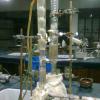Hello all,
i am conducting a poll here to find out the different conceptions that exist as to how a PSV works in respect to pressures especially to when a PSV reaches fully open .
Some engineers see a PSV fully open at 110% of set with the %open vs press curve between 100% and 110% either being linear or specific to a manufacturers valve.
Similarly for the drop in pressure from 110% down to 100% , linear vs pressure
others take fully open at set pressure and start to close at closing pressure so teh valve is in effect still fully open till 95% of set.
using simple figures below perhaps some of you could comment as to yes or no in respect to your views.
( i am polling general ideas here not exact)
121% max accum pressure for fire case
valve fully open 110% max accum pressure for non fire case
set pressure 100% ( design pressure say)
start to open 98%
closing pressure 95%
reseating pressure 93%
see attached dwg
looking fwd to comments on this
flarenuf
Attached Files
Edited by flarenuf, 04 February 2014 - 11:12 AM.

 FB
FB












